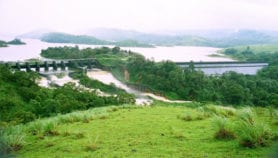By: T.V. Padma
Send to a friend
The details you provide on this page will not be used to send unsolicited email, and will not be sold to a 3rd party. See privacy policy.
[NEW DELHI] From fuel-efficient cooking stoves and solar lanterns to low-emission power plants, technology lies at the heart of the war on climate change for developed and developing countries alike.
Affordable and accessible technologies are needed to achieve low carbon livelihoods and adapt to the new climate order.
And technology transfer has become a pivotal issue in the run-up to the summit in Copenhagen next month, where the world hopes to hammer out a new global climate deal.
"That countries should come to an agreement on technology transfer is crucial to a fair global deal and thus to the success of any Copenhagen agreement," says Abdalmahmood Abdalhaleem Mohamad, representative from Sudan, speaking for the G-77 Plus China — a group of 77 developing countries and China — at a UN-supported meeting on climate technology transfer in Delhi last month (21 October).
Energy aspirations
Why is this technological assistance so vital for countries that emit only a small proportion of the world’s greenhouse gases?
The answer is their needs and aspirations. In developing countries, millions still lack basic resources such as food, clean water, sanitation and power. Almost one-third of the population in developing countries — 1.6 billion people — lacked access to electricity in 2005, according to the International Energy Agency’s 2009 World Energy Outlook report.
Energy poverty limits many activities that are vital to human, economic and social development, says Ambuj Sagar, professor of policy studies at the Indian Institute of Technology Delhi. As countries strive to end energy poverty, their carbon emissions are likely to soar.
"Meeting the climate and developmental challenges simultaneously will require a significant shift in the technological trajectory of developing countries," says Sagar.
"The global climate policy will succeed — or fail — depending on whether it brings low-emissions technologies, and technologies for adaptation, within the reach of poor countries and communities without further delay," agrees Sha Zukang, under-secretary general at the UN Department of Economic and Social Affairs.
And Supachai Panitchpakdi, secretary general to the United Nations Conference on Trade and Development, says: "Technology transfer to developing countries is a critical international public policy issue. So far discussions have not advanced with the urgency needed.

Panitchpakdi: "Technology transfer to developing countries is a critical international public policy issue"
Agência Brasil / Wikicommons
"Climate change demands urgent action. The world cannot afford to wait for these technologies to follow the usual path of gradual diffusion from rich to middle-income to poor countries."
Working out what you need
Most technology transfer related to climate change occurs between developed countries, who exchange with each other.
A 2008 Organization for Economic Cooperation and Development (OECD) study says that between 1985 and 2004, 80 per cent of mitigation-related technology transfers were between developed countries. The remaining 20 per cent went to China and Korea.
Transferring climate-friendly technologies to developing countries sounds simple but the obstacles are formidable.
Firstly, recipient countries must agree on their technology needs. So far, only 23 developing countries have submitted technological needs assessment plans to the UN Framework Convention on Climate Change (UNFCCC).
For a country even to understand its own needs is complex. Technologies invented elsewhere do not necessarily fit — many need extra research and development (R&D) to make them locally-relevant.
For indigenous technologies — local solutions for local problems — other problems prevail. Sagar points out that technologies and products such as lanterns and cooking stoves, which meet local needs, have often been developed locally. Such technologies are particularly important because they are relevant to so many people living in energy poverty.



Technology must be relevant to local adoption, such as improved cookstoves
Flickr/oneVillage Initiative
But development and deployment remains small and fragmented, except for isolated success stories such as the Chinese improved cook-stove programme. These technologies are generally outside the mainstream global energy innovation system and, in many cases, even outside the established commercial markets in developing countries.
Finance is only the first hurdle
In 2008, researchers in five Asian emerging economies — China, India, Indonesia, Malaysia, and Thailand — set out to understand their national technology needs and map the obstacles. They began a joint study, focusing on three mitigation technologies — clean coal, biofuels and solar power.
Last month, all five reported they did not have enough research or development in clean energy technologies. They lacked technological skills and training. Other common hurdles included the high capital costs of the technologies; legal obstacles such as negotiating intellectual property rights; social acceptance of new technologies; and, of course, cost.
Finance is possibly the simplest hurdle to clear. Most people agree that financial support must be scaled up for developing countries, in particular the most vulnerable.
UNFCCC general secretary Yvo de Boer estimates that rich countries need to put a ‘quick-start’ fund of US$10 billion on the table in Copenhagen.
In the longer-term, he says, some US$200 billion is needed for technology to reduce emissions, and an additional US$100 billion to help poor countries adapt to climate change.
Patents: Help or hindrance?
Equally daunting, and possibly more complex, is the issue of intellectual property rights (IPR).
Developed countries have long held that strong patent laws in developing countries would ease technology transfer.
Not so, say some. Amir Hisham Hashim, associate professor at the department of electrical power at Tenaga National University in Malaysia, is co-author of a five-nation Asian study that made a contentious claim. He says his own country’s experience is that strong domestic intellectual property laws do not necessarily reap technology transfer benefits (see Link between patent law and tech transfer not proven)



Five Asian emerging economies have started mapping out their needs in clean technologies such as solar power
Stefan Wernli
The study says that strictly enforced patent rights can restrict technology transfer, because they lead to high licence costs and can therefore obstruct the adaptation of knowledge to local conditions.
Effectively, the foreign technology owner determines how technology is deployed and whether it is improved or needs investment.
Some countries offer a radical solution to the IPR problem.
They suggest climate change be declared a national emergency since, under the World Trade Organization’s TRIPS (Trade-Related Aspects of Intellectual Property Rights) agreement countries can unilaterally relax their patent laws in such a case.
During the AIDS epidemic, a few countries — including Brazil and Thailand — used such compulsory licensing to buy cheaper anti-HIV drugs. "The moral case for protecting our planet and its life support system is equally compelling," India’s Prime Minister, Manmohan Singh, has argued.
Angelica Navarro, Bolivia’s chief climate negotiator, suggests the less controversial solution of "technology patent pools" — an agreement by multiple patent holders to share their intellectual property.
Even if developing countries can ease their financial and legal passage to clean technology, there are other pressing problems. They need the skills to adapt and use new climate friendly technologies — and to develop more themselves.
Local innovation capacity is especially important, argues Sagar, because climate change is a long-term, multi-decadal problem. It’s not simply a case of funding a few hi-tech labs but also of training the next generation of technically competent people, he says. Local education and research institutions must be strengthened and linked up to international innovation activities. But how?
Models to copy
Some developing countries are studying the Consultative Group on International Agricultural Research (CGIAR), which provides international support for food research and cooperation.
Although CGIAR promotes research, not technology transfer, and despite criticism that it is not particularly good at getting solutions into the field (see A Revolution to Combat World Hunger) the G-77 Plus China meeting’s consensus was that it should be explored as a possible model.
Indeed the ‘green revolution’ that sent Asian crop yields soaring, and in which CGIAR played such an important part, has inspired Mohammed Nasheed, president of the Maldives, to call for a "green power revolution". The green revolution relied on a mosaic of research institutes, education, credit, marketing and extension to get the knowledge to those who needed it.
Still others are looking to the Montreal Protocol, the global agreement that helped developing countries replace ozone-damaging chemicals in industry with more environment-friendly substitutes.
But some, for example Raghunath Mashelkar, former director general of India’s Council of Scientific and Industrial Research, point out that even with the Montreal Protocol, Indian producers could not always make a technology switch, either because of high fees or onerous restrictions.



Singh: "We need technology solutions that are appropriate, that are affordable and that are truly effective"
Flickr/London Summit
Ambitious plan needed urgently
Even a "Marshall Plan for developing country renewables" has been suggested, named after the plan for rebuilding Western Europe after the Second World War.
The G-77 plus China proposes setting up a multilateral climate technology fund under the UNFCCC. A technology action plan would define policies, actions and funding requirements. International technology cooperation would identify technological options for all sectors and removes barriers to development and technology transfer.
Meanwhile, India suggests an international developing-country-network of climate or technology innovation centres. These could identify locally relevant technologies, and help develop and deploy them faster. They would build regional, national and local capacity and foster idea sharing.
Sagar says international cooperation and collaboration on climate change R&D should have two elements. He wants developed countries to incorporate into their own R&D programmes activities to help developing countries mitigate and adapt to climate change.
And he argues for an international technology development and deployment effort, in the form of programmes or centres, possibly located in developing countries.
Rajendra Pachauri, chair of the Inter-Governmental Panel on Climate Change (IPCC), agrees, recommending a major energy R&D programme in developing countries.
However it is done, the aim will be the same. "The key issue before us (developing countries) is developing the appropriate technologies and then collapsing the time from the first commercialization to their large-scale adoption in poorer developing countries," India’s prime minister, Manmohan Singh, told the climate technology transfer meeting in Delhi.
"We need technology solutions that are appropriate, that are affordable and that are truly effective."
For more articles on clean technology visit our clean technology and Copenhagen subtopic which offers up-to-date news, opinions and features on clean technology and the developing world.
You can also receive the latest on clean technology and Copenhagen from SciDev.Net by signing up to our RSS feed or subscribing to our weekly email alert.













